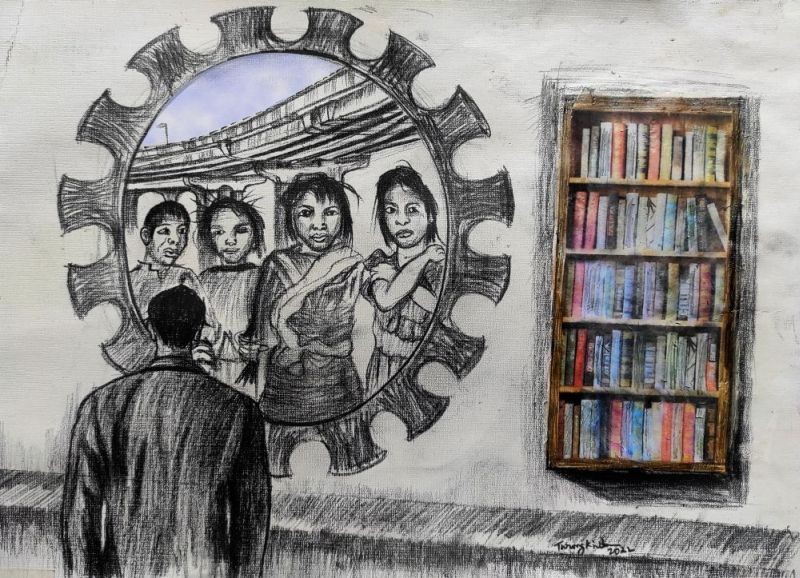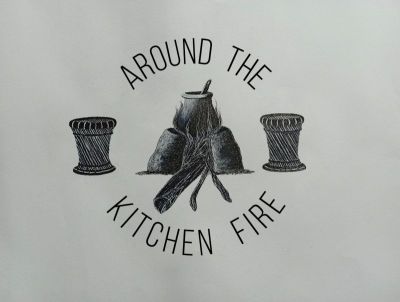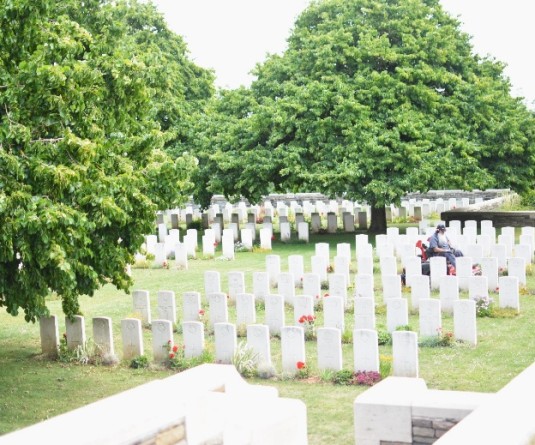This illustration 'Children under the Bridge' is by Naga artist Throngkiuba Yimchungru and you can contact him at: throngkiubayim@gmail.com


Dr Brainerd Prince
Imagine you have just landed in Delhi after presenting a paper in a research conference and you are on a taxi from the Indra Gandhi International Airport to Panchsheel where you live. Although the first stretch of road with its fancy lawn-work is beautiful, on the first turn right into the Outer Ring Road towards Vasant Vihar, you go under a flyover. As your car turns right, you look out of the left window and under the flyover you see about a dozen children playing. You look at them intently, at their torn clothes, muddled hair, and dark faces – you know at once that these are homeless children on the roads of the capital of ‘India Shining’. Before you can do anything, your taxi passes them by. The academic and the activist within you are wrestling to take control of your response. The activist wins, and you ask your taxi to pull over. You step out and walk back to the children. You try to speak to them, but they run away. You take out your wallet and they come running back. You give them a few rupees each. You take out your phone and call your friend who runs a children’s charity. He promises to look into it immediately, and assures you that he will try to provide a home for these kids.
Feeling a bit better, you walk back to the taxi, and the driver, slightly amused, drives on. What you didn’t expect was a similar scene under the Munirka Flyover. But here there are close to 50 kids playing. You only look, and the driver slyly looks at you through the rear-view mirror. You remain poker faced, and the taxi speeds on. Then at the IIT Flyover, there are close to 80 kids, and by the timeyou reach the Panchsheel Flyover there seems to be an entire school of children under the long-drawn flyover!
You finally reach home, and in the welcoming and the sharing of gifts with family, and the rest you so deserve after the hectic trip, everything is forgotten. But as the night falls, and you get into bed, the images of the children under the flyovers flash back brightly. You toss and turn, as the future of these children and the problem of their homelessness play havoc in your mind. You wake up early morning, and call your NGO friend, and he says that he has begun talks with the concerned authorities. You pledge to give financial aid for this project of rehabilitating homeless children.
Night falls again, and the images return. This time, the faces of the children – the little girl with the running nose, and the boy whose legs were full of sores. You jump out of bed, and literally ask out aloud – how is this possible! How can children be homeless in the capital city of India that is supposed to be exponentially growing economically? What is the State doing about this? You open your laptop and ‘google’ and find out that there are 18 million street children in India and 11 millionchildren in urban cities like Delhi. Furthermore, you also find out that the number of street children in India is the highest in the world.
Day Three: There is a calmness within you. It appears that while you were asleep, something happened to you, inside. Your ‘self’ figured itself out. You start to think and reflect on yourself as to why you have become calm. And as you sit at the breakfast table, suddenly the writing on the wall becomes meaningful. You, as a researcher, are destined to research on the theme of homeless children in India and you believe that your research will help change the status of these children. That is your future! You are going to search for answers to this problem of child-homelessness in urban India. The restlessness becomes restful. You begin to plan your next steps.
For many of us,experiences such as this canbecome defining events that get etched in one’s memory for a lifetime. For others, it can be a string of smaller events that brings us to the same state of existential unrest and rest.
By discovering one’s ‘existential calling’ the researcher stumbles on to a purpose that captures her heart and begins to define her life. Purpose can also be called a search, as it is a journey that one is beckoned towards.
She finds herself responding to this tug that has come from the experiences she has had. And yet, it equally opens up an ‘already existing’ deep longing within oneself. There is a good fit between the ‘outside pull’ and the ‘inside push’ which then has the power to establish the ‘search’ within.
I have called this ‘outside pull’ as ‘the children under the bridge’ who arrest our attention and redirect our lives. We, on our own, don’t know and we will never know who these children are under the bridge. The children will have to find us and reveal themselves to us!
This is the main characteristic of an authentic search – the search has to find us and we have absolutely no clue about where the answer lies. The search, thus, begins with a true quest of determining what the search is all about, or who the children are for us.
The event or the string of events that entered your horizon possesses a double representation with a ‘temporal continuity’ from the past to the future even as it meets your present. What that means is that the life-changing event that you encountered in your present has a long history of complex problems as well as it anticipates a future where there is hope of resolving these problems. Thus, on the one hand, it represents a historical problem that needs to be solved, while, on the other hand, it also depicts a dream or desire to build something constructive in the future. Hence, the search is like a coin with two sides – a historical problem to solve and an imaginative proposal to build. It doesn’t really matter what enters your horizon first and keeps you awake, be it the historical problem or the imaginative proposal, both come together as a package even if it was one of them that caught your initial attention.
Once the search is established and its direction determined, then our entire being gets behind the project. The initial passivity will give way to extreme proactivity even as you ready yourself for the search. The first goal is to establish and state clearly the theme. What exactly are we searching for? Themes lies in the realm of language. For the first time you are going to articulate in language the intense feelings, desires and the anguish of the soul you have felt and experienced so far. Although this is not something new and we do it all the time, that is put words to experience, but because we are talking about research, we need to understand what is happening when we put in language our experiences.
There is a huge underlyingdebateon how language relates to reality. On the one hand, language is a thing-in-the-world similar to other things like tables, and chairs that make up the architecture of the world.However, on the other hand, language also describes the world and re-presents it while continuing to be part of the world that it represents. Because of this complex relationship, however self-reflexive language can be made to be, it still will never be able to exhaustively represent the world – there will always be a gap between reality and its linguistic representation. There will always be a limitation and a slight hiddenness in all representations. Therefore, even the theme that we articulate in language will necessarily be limited and will not completely capture our experience. Hence, we use the language of ‘provisionality’. All our naming in language is always ‘provisional’, subject to change on further discovery.
If the ‘defining event’ or ‘the stream of events’ is an ‘experience-in-the-world’ like the experience of the children under the bridge, then the naming of the theme can fall on two sides. Either it captures the subjective experience of the event or it represents the outside event that birthed the inner experience. The goal of finding the appropriate theme then is to hold these two sides together, as much as possible, so as to not lose this two-sided complexity and, if I may say, the beauty, of the experience.
Articulating the theme with this double-sided complexity is not an easy task that can be done in a short time. There is a process involved that enables this naming. This process has three parts: It begins with (a) reflective thinking that results in (b)a narrative writing which would then culminate with a (c) first-order abstraction of the theme. While I am not claiming that this is the only way to arrive at the theme, I have found it to be a useful process, as it offers a structure and a format to present something that otherwise could be purelypersonal and subjective. Let’s unpack this in the next issue.
Dr. Brainerd Prince teaches and tutors students on academic and research skills. He consults for higher education institutions on research, academic skill training and on designing research programmes. Contact: samvada.research@gmail.com





